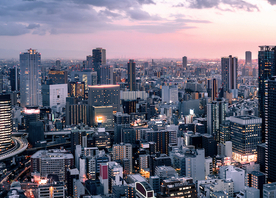If you’ve ever wanted to experience a traditional Japanese onsen, then Kinosaki Onsen Resort Town near Kyoto is a must-visit destination.

Intro
Kinosaki Onsen Resort Town brings together a number of quintessentially Japanese experiences in one beautiful, picturesque location. First of all, onsen. These geothermal hot springs are at the heart of Japan’s bathing culture. Lowering your body into an onsen in a bathhouse or ryokan is a perfect way to experience this ancient Japanese tradition. Kinosaki has public and private baths throughout the pretty town and also has a wide range of ryokan - traditional Japanese inns - for visitors to stay overnight or longer. It’s essentially the Japanese equivalent of a spa town. The area, like the whole of Japan, is also famous for its incredible food, and you’ll find lots of attractions nearby Kinosaki too, from mountain ropeways and serene temples to sandy white beaches. In this guide, you’ll find everything you need to know about visiting Kinosaki Onsen Town and how to get there with the Japan Rail Pass. Ready to relax Japanese-style? We’re about to begin. A Brief History of Kinosaki Onsen Town
Located in a breath-taking green valley in the Kansai region, Kinosaki dates back 1,300 years, and its hot springs were first discovered in the 8th century - making it one of the oldest in Japan. Water being heated without human intervention was seen as the work of the gods and therefore onsen were worshipped as sacred places. It was also believed that the hot spring waters were created by the guardian deity who watched over and protected the town and its people. It was traditional to hike Mount Daishi and visit Onsenji Temple before bathing in the sacred waters of the seven mystic onsen. We’ll have more about the seven public onsen of Kinosaki further below. Since then, this beautiful, traditional-looking Japanese town has been a favourite destination for people from across Japan and more recently, international travellers. On arrival, you’ll discover gorgeous wooden buildings with sukiya architecture, the Willow-lined Otani-gawa river, residents and visitors wearing yukata robes (also known as summer kimonos) and geta (wooden clogs), quaint local shops selling crafts, gifts, and souvenirs, and so many traditional onsen and ryokan that you’ll be spoilt for choice.

The Seven Public Onsen of Kinosaki
What is an onsen? As we mentioned above, an onsen is a geothermal hot spring, and since Japan is one of the most volcanically active countries, onsen are plentiful. The word means more than just a hot spring though. It also extends out to encompass bathing facilities, Japanese bath houses, as well as hotels/inns, traditional ryokan, and spas that are built surrounding the landmark. Besides being a communal activity for family and friends to enjoy, onsen have deep ties within Japanese culture. If you are looking to get the full experience of Japan by diving deep into cultural norms, onsen should be on your to-do list. Aside from the cultural ties, the geothermally heated springs offer potential benefits such as relieving pain, stress, and fatigue, and improving your skin. Onsens are separated by gender, you take off all your clothes (no bathing suits), and tattoos usually need to be covered up, although Kinosaki is a bit more relaxed about the latter than the rest of Japan.
As well as a number of private onsen, Kinosaki famously has seven public onsen. If you’re staying at a ryokan in the town, you can often visit these onsen for free. The seven onsen are:
1.) Kono-yu
Believed to be the oldest onsen in Kinosaki, this was discovered when a villager saw an oriental white stork healing its wounds in the water. Since then, oriental white storks have been closely associated with Kinosaki.
2.) Mandara-yu
Another ancient Kinosaki onsen, mandara means enlightened mind.
3.) Goshono-yu
Known as the water of beauty, this stunning building was modelled on Kyoto Imperial Palace.
4.) Ichino-yu
Featuring a bathhouse made from a cave of natural boulders, the exterior also resembles a Kabuki theatre
5.) Yanagi-yu
This onsen takes its name (which means weeping willow) from the trees that line the pretty street outside.
6.) Jizo-yu
A favourite with locals, the building is shaped like a Japanese lantern.
7.) Satono-yu
Featuring an outdoor bath and observation desk, this luxurious onsen has panoramic views. Top 10 Things To Do in Kinosaki
Kinosaki is an onsen town, so soaking in the gorgeous hot water is obviously at the top of our list. However, that’s not the only thing to enjoy. Kinosaki is packed full of attractions that make it a great all-round destination. Here are our top ten:
1.) Enjoy the onsen
Naturally, the onsen themselves are at the top of our list. As well as the seven mystic onsen listed above, there are numerous private onsen, plus many of the ryokans also feature onsen on the premises. It’s the number one reason for visiting this lovely town, and an amazing way to experience an important part of Japanese culture. No two onsen are the same, so it’s worth trying as many as you can. Tickets can be purchased from each onsen for 700-800 yen, although admittance is often free with a pass from a ryokan where you are staying. You can bring your own towels or rent them from the bath house, while soap and shampoo are provided. Unlike the west, it is customary to wash yourself before entering the water. You could even follow in the footsteps of Kinosaki visitors from across the centuries by attending Onsenji Temple to pray before visiting all seven public onsen. There’s even an onsen festival each year in April if you happen to visit during the spring.
2.) Stay in a Ryokan
Ryokans are traditional Japanese inns which date back hundreds of years to the days of the samurai. While they were originally built as places to stay for wandering samurai and other visitors, today they offer Japan’s most authentic and traditional accommodation for visitors. With gorgeous wooden architecture, tatami floors, sliding shoji paper doors, beautiful gardens, and more, they offer everything you would hope for from a traditional Japanese experience. Staying at a ryokan isn’t just about a place to spend the night either, it’s a complete experience from the moment you arrive, and you’ll often be served regional Japanese food, observe traditional customs, and get the chance to try activities like tea ceremonies and more. Kinosaki has a wide range of ryokan for visitors, from five-star luxury retreats to more affordable options. Either way, they make the perfect accompaniment to the town’s sacred onsen. You’ll find ryokan across Japan. To find out more read our guide to The Best Ryokans in Japan.
3.) Try the incredible food
If we’ve said it once, we’ve said it one thousand times - Japan is a paradise for food-lovers. It truly is one of the best places on the planet to visit if you enjoy food, and Kinosaki is no exception. The town is famous for its seafood in particular, but also Tajima beef - a form of Kobe beef, which alongside Japanese wagyu is considered the best in the world. The seafood from the area is also exceptional, and matsuba crab is a particular speciality. Kinosaki is also known for kaiseki - this is a special 12-course menu, which is a true celebration of food. Find out more about Japanese food in our Beginners Guide to Regional Japanese Dishes.
4.) Hike Mount Daishi
Traditionally, those who bathed in the sacred waters of Kinosaki would hike up Mount Daishi to pray at Onsenji Temple before soaking in the onsen. Today, hiking and climbing is a hugely popular activity in Japan, and the beautiful mountainous valley above Kinosaki is home to many hiking trails and courses. And of course, after walking and hiking, there’s no better remedy than a long soak in a beautifully warm hot spring.
5.) Spectacular views from the Kinosaki Ropeway
While hiking up the mountain was the traditional way to ascend, there’s also a more contemporary method - the Kinosaki Ropeway, which connects Onsenji Temple and the summit. This cable car can take you up the mountain at a more relaxed pace and offers views over Kinosaki, the Maruyama River and the Sea of Japan. Onsenji Temple is also at the ropeway’s middle station, while at the uppermost deck there is an observation platform with the most spectacular panoramic views of the area. If you visit Kinosaki, the ropeway and its views are unmissable.
6.) Visit San’in Kaigan Geopark
A massive national ‘geopark’, San’in Kaigan is a little further afield but well worth a visit. The UNESCO awarded site is home to the Genbudo Caves - an enormous basalt cave system formed millions of years ago. There is a museum dedicated to the caves and a huge number of outdoor activities on offer across the park such as cycling and sea kayaking.
7.) See the white storks
The Oriental white stork is part of the mythology of Kinosaki onsen town, but the bird itself is close to extinction. Thankfully, sanctuaries such as Hyogo Park and Konotori no Sato Park exist to reintroduce this beautiful bird to Japan. A museum and breeding habitat, Konotori no Sato Park and Hyogo Park give visitors a chance to view the Oriental white stork and learn more about it. For more animal adventures read our Wildlife Tour of Japan.
8.) Relax at Takeno Beach
Rated one of the 100 best beaches in Japan, Takeno Beach near Kinosaki offers white sand and crystal blue waters - what more could you want!
9.) Visit Onsenji Temple
This beautiful wooden temple on Mount Daishi is dedicated to the Buddhist saint who prayed for 1,000 days to bring spring water to Kinosaki. The temple is also home to an eleven-headed, two-metre-tall Kannon Buddha, which is only fully displayed to the public every 33 years. A visit can easily be combined with a journey on the Kinosaki Ropeway and hike up the summit of Mt. Daishi, making for a brilliant day’s itinerary.
10.) Kinosaki Marine world
This excellent aquarium can be found on the cliffs of Hiyoriyama, north of Kinosaki. Special features include being able to catch your own aji (horse mackerel) and have it cooked in front of you for dinner, and a diving tank that lowers you into the ‘sea’ for a fish-eye view of the world without getting wet. Japan boasts some of the world’s finest aquariums and most spectacular sea life. Read our guide to Splash! Japan’s Best Aquariums to find out more and read our recommendations.
Alongside these top ten, we also highly recommend you enjoy the picturesque town itself and all of its amenities. After you’ve done our top ten, just take a stroll along Kiyamachi Street in your yukata and geta - it doesn’t get more relaxing (unless you’re soaking in an onsen). How To Get To Kinosaki Onsen Resort Town
Finally, when to visit? Kinosaki onsen can be enjoyed all year round. It’s a popular winter destination, as the town looks incredibly pretty and the hot springs are amazing in cold weather, but it’s equally popular in spring, summer and autumn too. Bonus Recommendations
- Looking for another onsen town elsewhere in Japan? Atami in Shizuoka Prefecture, just 50 minutes from Tokyo using the Japan Rail Pass, is another picturesque onsen town to experience. Our guide to Visiting Atami Onsen Town has all you need to know.
- Another popular onsen is Wakura onsen, which is on the edge of Nanao bay, north of Kanazawa. Our guide to Wakura onsen has more information.
- Staying in a big city like Tokyo, but still want to sample an onsen? No problem. Read our guide to the Top Five Onsen in Tokyo for our best recommendations.
- Onsens are an amazing way to detox and relax, but they are not the only way in Japan. Our guide to Detox in Japan has everything you need to know.




.jpg)
